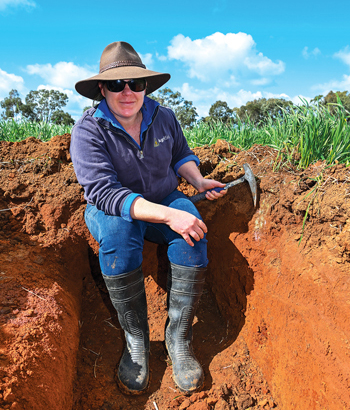Almost 200 growers from as far north as central NSW and south to north-eastern Victoria have volunteered to find ways to lift on-farm profitability while lowering greenhouse gas (GHG) emissions.
The not-for-profit partnership known as the Cool Soil Initiative started in 2018 with funding from Mars Petcare to create a paddock-to-plate program to help wheat growers improve soil health, maintain or increase grain yields, track GHG emissions and look for opportunities to reduce these.
Cool Soil Initiative director Fiona McCredie told the 2024 GRDC Grains Research Update at Wagga Wagga that many supply chain companies already needed to know the GHG emissions associated with producing grain. She said companies had to account for them as Scope 3 emissions, and this would likely expand in the future.
“It’s why the Cool Soil Initiative started. It is about making farms more productive and profitable while also achieving sustainability goals,” Ms McCredie said. “It is driven by various partners who want to work with growers to source grain sustainably.”
In 2020, corporate involvement in the partnership expanded from Mars Petcare to Kellanova, Allied Pinnacle, Corson, Manildra Group and PepsiCo. The Food Agility Co-operative Research Centre was a partner from 2020 to 2023.
Charles Sturt University (CSU) and the Sustainable Food Lab also contribute research, knowledge, data security and information technology support.
The Central West Farming Systems group, FarmLink and the Irrigation Research and Extension Committee provide on-farm monitoring for the Cool Soil Initiative.
South of Wagga Wagga and into Victoria, Corowa grower Anna Dye collects on-farm data from growers in the Cool Soil Initiative and supports communication. Ms McCredie said efforts were underway to expand the program into other states, starting with WA.
Grower benefits
When growers join the program, they receive five free soil tests for five paddocks yearly. The results are shared with each grower.
Participants complete paddock histories outlining fertiliser, herbicides, crop protection and crops grown. An on-the-ground support person usually collects this data, including the soil samples.
“That data is quality assured, which the companies have insisted on,” Ms McCredie said. “Our partners have to be confident the number that comes out is the right number and has a credible process behind it.”
Figure 1: Cool Soil Initiative by numbers.

Source: The Cool Soil Initiative
In return, the Cool Soil Initiative aims to help growers:
- identify how to maintain or increase crop yields more efficiently;
- understand where they sit in terms of a range of metrics and how they compare to other growers regionally (all data is anonymised);
- reduce their GHG emissions;
- comprehend data to support decision-making and improve productivity and profitability; and
- access support to try new approaches and refine on-farm practices.
Growers retain ownership of their data and agree to share it with the Cool Soil Initiative and its partners. All information is anonymised when it enters the CSU database, which is maintained securely.
 Cool Soil Initiative principal scientist and AgriSci director Dr Cassandra Schefe discussing soil acidity at a FarmLink field day. Photo: Nicole Baxter
Cool Soil Initiative principal scientist and AgriSci director Dr Cassandra Schefe discussing soil acidity at a FarmLink field day. Photo: Nicole Baxter
Cool Soils Initiative principal scientist and AgriSci director Dr Cassandra Schefe said the Cool Soil Initiative was actively working on opportunities for growers to use their reports to access additional financial benefits.
She said the corporate partners have no access to the database and cannot request data.
“We provide a yearly ‘impact report’ on regional GHG emissions and associated farmer practices,” she said. “For example, we emphasise minimum tillage rather than zero tillage because growers need to be able to use deep tillage to mix lime and gypsum into their soils.”
The impact report also details how many growers have legumes in their rotation, use controlled-traffic farming and aim to increase their pHCa through liming.
For corporate partners, she said the reported figures, based on the tonnage of wheat sourced, align with global rules around Scope 3 emissions. These emissions result from activities from assets not owned or controlled by the reporting organisation (such as Cool Soil Initiative growers).
The benefits for corporate partners are:
- regional Scope 3 GHG emissions data from grower activity in Australia rather than estimates;
- Australian grain becomes more attractive internationally as a food and feed ingredient because corporate partners can verify it is a low-emission product through the Cool Soil Initiative;
- Cool Soil Initiative’s GHG emissions data, refined for Australian conditions, is about one-third less than estimates from other baseline data systems and are internationally verified;
- reduced Scope 3 GHG emissions, which reduces companies’ need to buy carbon offsets; and
- insights into how Australian grain growers sustainably grow the grain they buy.
Ms McCredie said corporate partners are provided with the seasonal context.
“The seasonal conditions and the tonnage produced will affect the intensity of the GHG emissions,” she said.
“We report to our partners the farming practices and the changes in these that we see over time.”
What are scopes 1, 2 and 3 emissions for growers?
Scope 1 emissions include those released when fuel is burned in vehicles and machinery, and emissions from agricultural soils, such as nitrous oxide from applying nitrogen fertilisers.
Scope 2 emissions represent ‘indirect’ emissions released outside the business you imported and used – for example, electricity used for aeration cooling.
Scope 3 emissions are broader ‘indirect’ emissions that occur outside your business but as a result of your activities, those associated with producing inputs such as fertilisers, herbicides and fuel.
More information: Fiona McCredie, coolsoil@csu.edu.au;
Cassandra Schefe, cassandra@agrisci.com.au
Useful resources
Cool Soil Initiative
The Cool Soil Initiative: A farmer-focused, scalable framework for emission reporting through the supply chain, Fiona McCredie (The Cool Soil Initiative).

























































